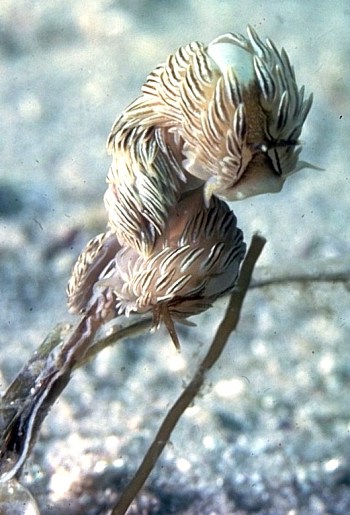
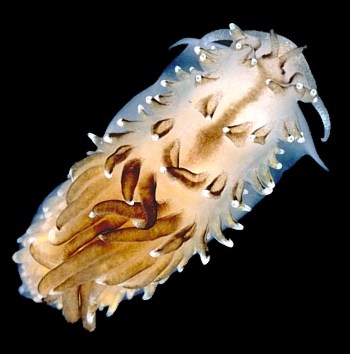
Cerberilla incola
Burn, 1974.
Order: NUDIBRANCHIA
Suborder: AEOLIDINA
Family: Aeolidiidae
DISTRIBUTION
Previously known only from southeastern Australia, but a recent message on the Forum [#23150] from Reunion Id, Indian Ocean, suggest that it is a widespread Indo-West Pacific species.
PHOTO
UPPER: Two adults, 'The Nursery', Jervis Bay, New South Wales, Australia, 15m on sand, March 1979. PHOTO: M. Scotland.
LOWER: 15mm animal, near Huskisson, Jervis Bay, sandy bottom, 8m, November 1984. PHOTO: Bill Rudman.
Animals up to 10mm are not uncommon in grab samples from sandy bays, but it is seldom seen alive. Clearly it spends its life buried in the sand, perhaps emerging at night. I have never seen large adult specimens, as illustrated in the top photo.
It is characterised by the two longitudinal brown lines on the cerata. In juveniles only the largest cerata have the brown lines, the smaller cerata being a uniform translucent brown colour.
Reference:
• Burn, R.F. (1974). Notes on some benthonic opisthobranchs from Port Philip Bay, Victoria. Journ. Malac. Soc. Australasia, 3(1): 43-57
Rudman, W.B., 1999 (November 26) Cerberilla incola Burn, 1974.. [In] Sea Slug Forum. Australian Museum, Sydney. Available from http://www.seaslugforum.net/find/cerbinco
Related messages
Cerberilla incola from sthn Queensland
May 20, 2010
From: Gary Cobb
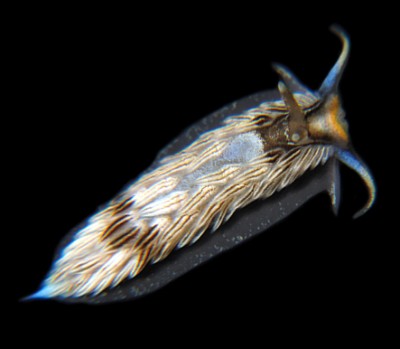
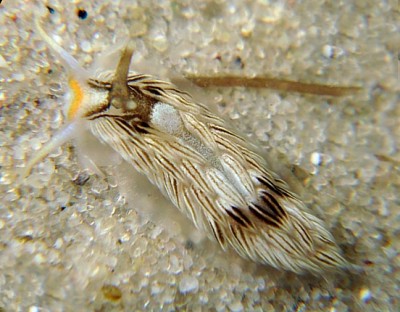
Concerning message #23150:
Hi Bill and everyone!
Well it was going to a great day so we headed off to Moreton Island and Flinders Reef. After a couple dives there we usually head to Bulwer Beach and have lunch. While there we jumped in and did some sieving and searching for nudibranchs. I did find Cerberilla incola scooting along the white sand. This animal made no attempts at burying itself. And so i share the photos with you to update your distribution. This brings our total of finds to 422!
Locality: Moreton Island, 2.5 m depth, Queensland Australia, Pacific Ocean, 15 May 2010, Subtidal about 30 m from shore. Length: 11 mm. Photographer: Gary Cobb.
Cheers
Gary
gary@nudibranch.com.au
Cobb, G.C., 2010 (May 20) Cerberilla incola from sthn Queensland. [Message in] Sea Slug Forum. Australian Museum, Sydney. Available from http://www.seaslugforum.net/find/23659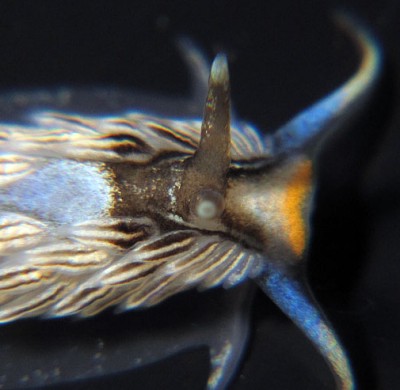
Dear Gary,
Thanks for this record. It seems to suggest we have to add an orange-yellow band on the anterior end of the head and yellowish tips to the oral tentacles, as possible colour characters of this species. It is an interesting, but not unique example, of a species we initially thought was a temperate endemic from the fringe of the tropical Indo-West Pacific, turns out to have a widepread tropical/subtropical range.
Best wishes,
Bill Rudman
Cerberilla incola from the Indian Ocean!
February 17, 2010
From: Sully Bachel
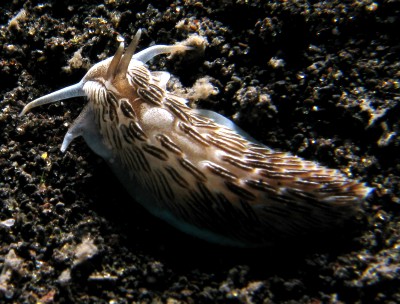
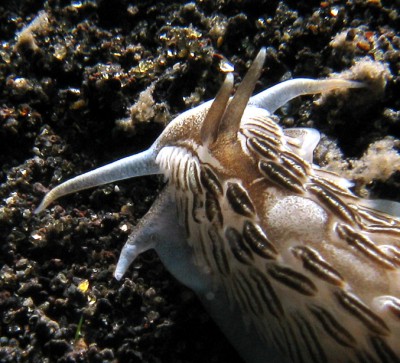
Concerning message #1613:
Hello Bill
I have found this nudibranch on a sandy bottom in a field of Cérianthaires near several Cerberilla affinis.
Locality: La Possession, 9 m, La Reunion, Indian Ocean, 14 December 2009, Intertidal - sandy bottom. Length: 25 - 30 mm. Photographer: Sully Bachel.
I suppose it is a Cerberilla incola.
What is your opinion.
Best regards
Sully
s.bachel@orange.fr
Bachel, S., 2010 (Feb 17) Cerberilla incola from the Indian Ocean!. [Message in] Sea Slug Forum. Australian Museum, Sydney. Available from http://www.seaslugforum.net/find/23150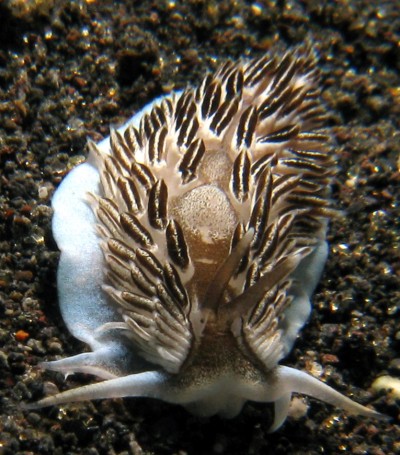
Dear Sully,
I have always considered C. incola to be a species confined to temperate waters of southeastern Australia, but your animals from Reunion Island are identical in colour, so I guess I will have to revise my views. Since we sometimes get widespread Indo-Pacific species occurring in southeastern Australia, it is certainly not silly to think your animals are the same.
Why has it not been recorded from other parts of this vast area? I guess its habit, like all species of Cerberilla, to burrow in sandy and silty bottoms, means that it is seldom seen. This is an interesting find
Best wishes,
Bill Rudman
Cerberilla incola from south eastern Australia
November 27, 1999
From: Bill Rudman.
The Cerberilla representation is growing very quickly! Here is a page on another species, Cerberilla incola, which is apparently endemic to southeastern Australia.
Bill Rudman.
